2005 Hyundai Azera tires
[x] Cancel search: tiresPage 262 of 297
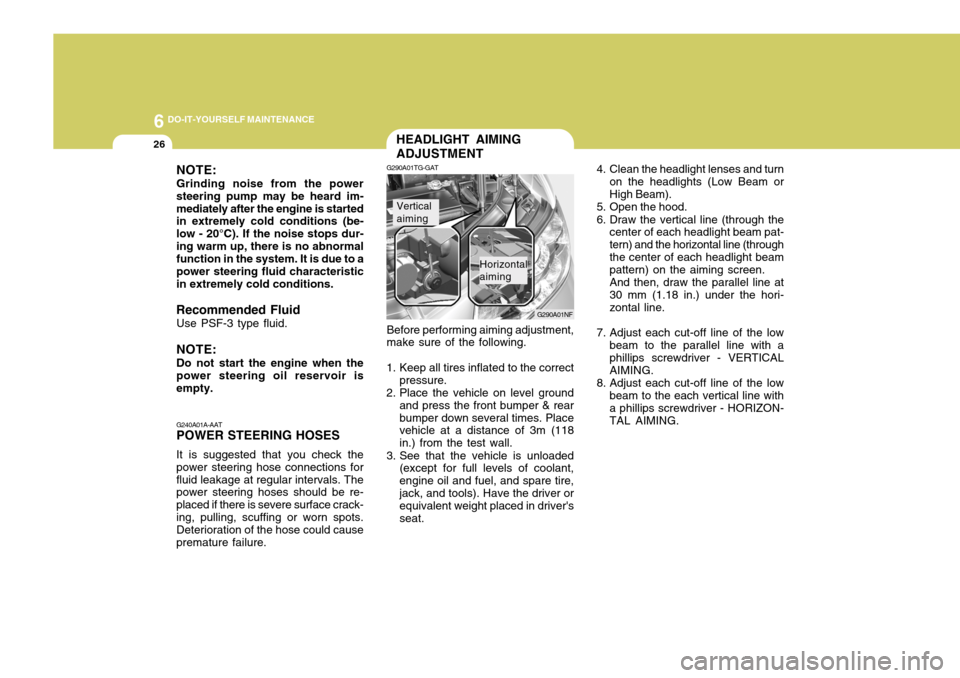
6 DO-IT-YOURSELF MAINTENANCE
26HEADLIGHT AIMING ADJUSTMENT
G290A01TG-GAT
G290A01NF
Before performing aiming adjustment, make sure of the following.
1. Keep all tires inflated to the correct pressure.
2. Place the vehicle on level ground and press the front bumper & rear bumper down several times. Place vehicle at a distance of 3m (118 in.) from the test wall.
3. See that the vehicle is unloaded (except for full levels of coolant,engine oil and fuel, and spare tire,jack, and tools). Have the driver or equivalent weight placed in driver's seat.
Vertical aiming
Horizontal aiming 4. Clean the headlight lenses and turn
on the headlights (Low Beam or High Beam).
5. Open the hood.
6. Draw the vertical line (through the center of each headlight beam pat- tern) and the horizontal line (throughthe center of each headlight beam pattern) on the aiming screen. And then, draw the parallel line at 30 mm (1.18 in.) under the hori- zontal line.
7. Adjust each cut-off line of the low beam to the parallel line with a phillips screwdriver - VERTICAL AIMING.
8. Adjust each cut-off line of the low beam to the each vertical line with a phillips screwdriver - HORIZON-TAL AIMING.
NOTE: Grinding noise from the power steering pump may be heard im-mediately after the engine is started in extremely cold conditions (be- low - 20°C). If the noise stops dur-ing warm up, there is no abnormal function in the system. It is due to a power steering fluid characteristicin extremely cold conditions.
Recommended Fluid Use PSF-3 type fluid. NOTE: Do not start the engine when the power steering oil reservoir is empty. G240A01A-AAT POWER STEERING HOSES It is suggested that you check the power steering hose connections forfluid leakage at regular intervals. The power steering hoses should be re- placed if there is severe surface crack-ing, pulling, scuffing or worn spots. Deterioration of the hose could cause premature failure.
Page 282 of 297
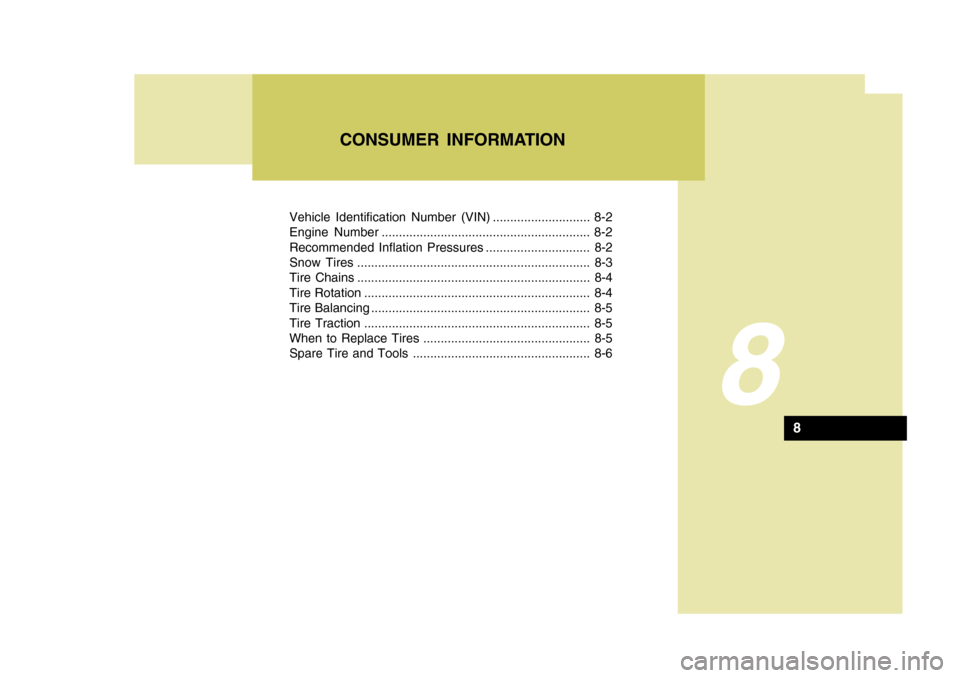
Vehicle Identification Number (VIN) ............................ 8-2
Engine Number ............................................................ 8-2
Recommended Inflation Pressures .............................. 8-2
Snow Tires ................................................................... 8-3
Tire Chains ................................................................... 8-4
Tire Rotation ................................................................. 8-4
Tire Balancing ............................................................... 8-5
Tire Traction ................................................................. 8-5
When to Replace Tires ................................................ 8-5
Spare Tire and Tools ................................................... 8-6
8
CONSUMER INFORMATION
8
Page 283 of 297
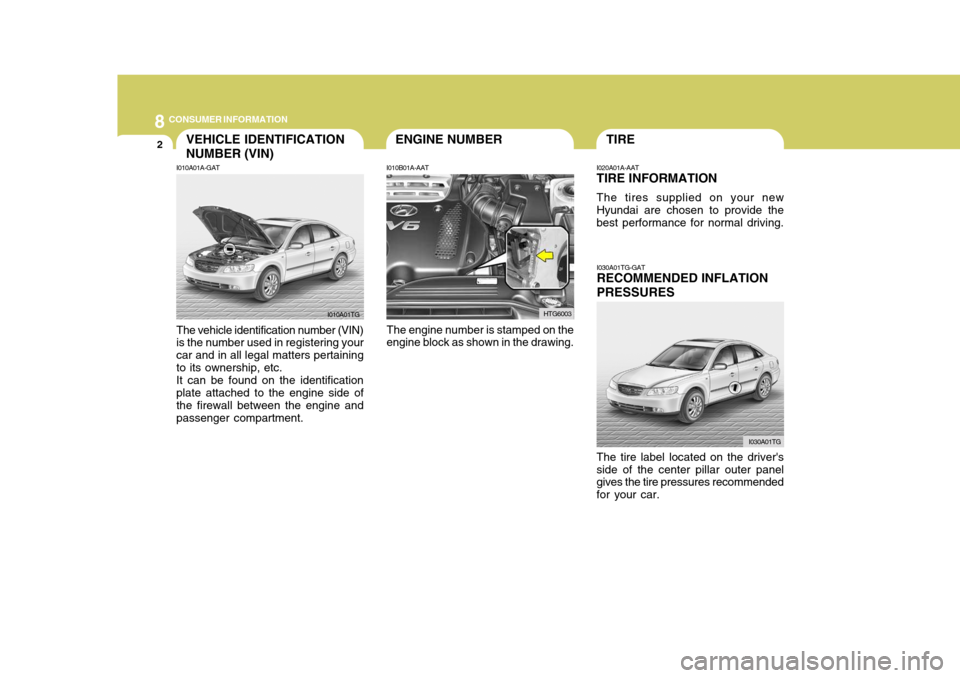
8CONSUMER INFORMATION
2TIREVEHICLE IDENTIFICATION NUMBER (VIN)
I010B01A-AAT
I010A01A-GAT The vehicle identification number (VIN) is the number used in registering your car and in all legal matters pertainingto its ownership, etc.It can be found on the identificationplate attached to the engine side of the firewall between the engine and passenger compartment. The engine number is stamped on the
engine block as shown in the drawing. I020A01A-AAT TIRE INFORMATION The tires supplied on your new Hyundai are chosen to provide the best performance for normal driving.
I030A01TG-GAT RECOMMENDED INFLATION PRESSURES
The tire label located on the driver's side of the center pillar outer panel gives the tire pressures recommended for your car.
I010A01TG
HTG6003
I030A01TG
ENGINE NUMBER
Page 284 of 297
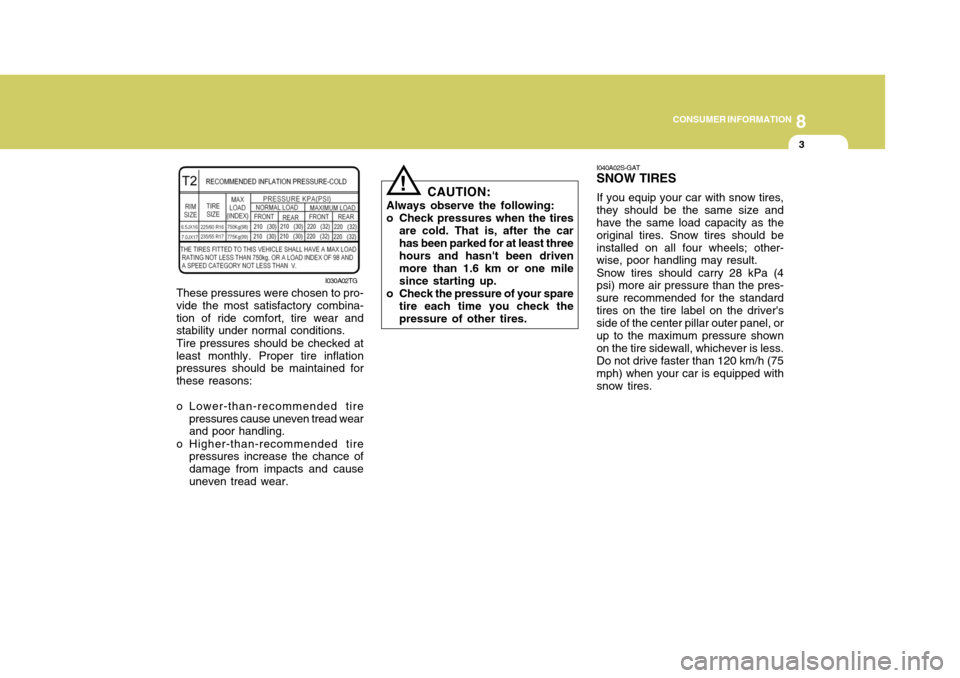
8
CONSUMER INFORMATION
3
CAUTION:
Always observe the following:
o Check pressures when the tires are cold. That is, after the carhas been parked for at least three hours and hasn't been driven more than 1.6 km or one milesince starting up.
o Check the pressure of your spare tire each time you check thepressure of other tires.
These pressures were chosen to pro-vide the most satisfactory combina-tion of ride comfort, tire wear and stability under normal conditions. Tire pressures should be checked at least monthly. Proper tire inflation pressures should be maintained for these reasons:
o Lower-than-recommended tire
pressures cause uneven tread wear and poor handling.
o Higher-than-recommended tire pressures increase the chance of damage from impacts and causeuneven tread wear.
! I040A02S-GAT SNOW TIRES If you equip your car with snow tires, they should be the same size and have the same load capacity as the original tires. Snow tires should beinstalled on all four wheels; other- wise, poor handling may result. Snow tires should carry 28 kPa (4 psi) more air pressure than the pres- sure recommended for the standardtires on the tire label on the driver's side of the center pillar outer panel, or up to the maximum pressure shownon the tire sidewall, whichever is less.Do not drive faster than 120 km/h (75mph) when your car is equipped withsnow tires.
I030A02TG
Page 285 of 297
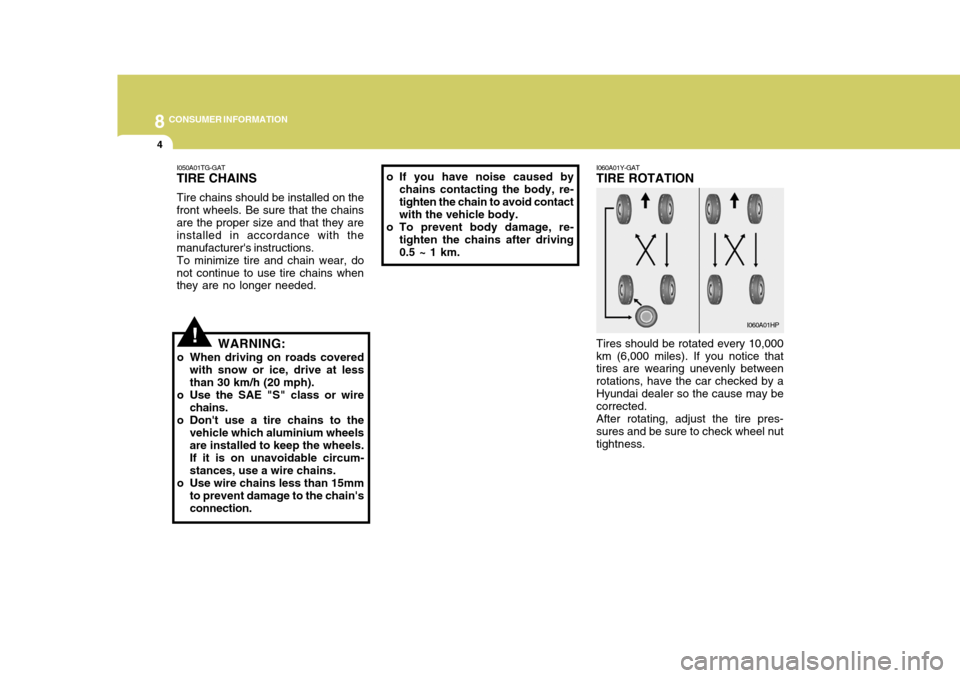
8CONSUMER INFORMATION
4
!
I060A01Y-GAT TIRE ROTATION Tires should be rotated every 10,000 km (6,000 miles). If you notice that tires are wearing unevenly between rotations, have the car checked by aHyundai dealer so the cause may be corrected. After rotating, adjust the tire pres- sures and be sure to check wheel nut tightness.
I050A01TG-GAT
TIRE CHAINS
Tire chains should be installed on the
front wheels. Be sure that the chains are the proper size and that they are installed in accordance with themanufacturer's instructions. To minimize tire and chain wear, do
not continue to use tire chains when they are no longer needed.
WARNING:
o When driving on roads covered with snow or ice, drive at less than 30 km/h (20 mph).
o Use the SAE "S" class or wire
chains.
o Don't use a tire chains to the
vehicle which aluminium wheelsare installed to keep the wheels. If it is on unavoidable circum- stances, use a wire chains.
o Use wire chains less than 15mm to prevent damage to the chain'sconnection. o If you have noise caused by
chains contacting the body, re-tighten the chain to avoid contact with the vehicle body.
o To prevent body damage, re- tighten the chains after driving 0.5 ~ 1 km.
I060A01HP
Page 286 of 297

8
CONSUMER INFORMATION
5
!WARNING:
Do not mix bias-ply and radial-ply
tires under any circumstances. This may cause dangerous handling characteristics that may cause death, serious injury, or propertydamage. I070A01A-AAT TIRE BALANCING A tire that is out of balance may affect handling and tire wear. The tires on your Hyundai were balanced before the car was delivered but may needbalancing again during the years you own the car. Whenever a tire is dismounted for repair, it should be rebalanced before being reinstalled on the car. I080A01A-AAT TIRE TRACTION Tire traction can be reduced if you drive on worn tires, tires that are improperly inflated or on slippery road surfaces. Tires should be replacedwhen tread wear indicators appear. To reduce the possibility of losing control, slow down whenever there israin, snow or ice on the road.
I090A01Y-GAT WHEN TO REPLACE TIRES The original tires on your car have tread wear indicators. The tread wear indicators appear when the treaddepth is 1.6 mm (0.06 in.). The tire should be replaced when these ap- pear as a solid bar across two ormore grooves of the tread. Always replace your tires with those of the recommended size. If you changewheels, the new wheel's rim width and offset must meet Hyundai speci- fications.HTG5016
Tread wear indicator
1.6 mm (0.06 in.)
Page 287 of 297
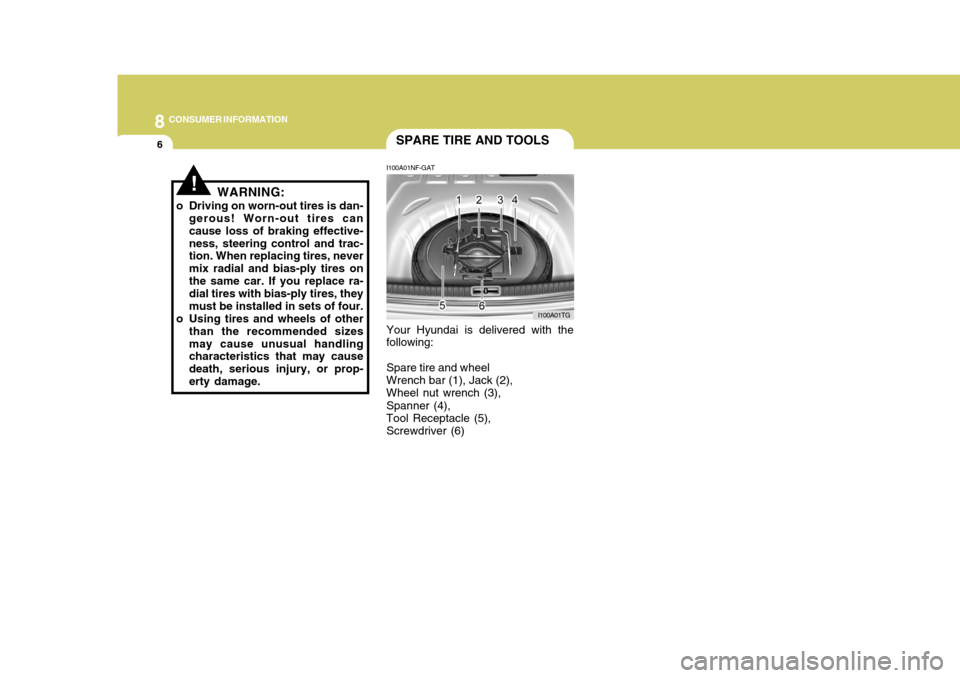
8CONSUMER INFORMATION
6
!
SPARE TIRE AND TOOLS
I100A01NF-GAT Your Hyundai is delivered with the following: Spare tire and wheel Wrench bar (1), Jack (2), Wheel nut wrench (3), Spanner (4), Tool Receptacle (5), Screwdriver (6)
WARNING:
o Driving on worn-out tires is dan- gerous! Worn-out tires can cause loss of braking effective-ness, steering control and trac- tion. When replacing tires, never mix radial and bias-ply tires onthe same car. If you replace ra- dial tires with bias-ply tires, they must be installed in sets of four.
o Using tires and wheels of other than the recommended sizesmay cause unusual handling characteristics that may cause death, serious injury, or prop-erty damage. I100A01TG
Page 296 of 297

10
INDEX
5
O Odometer ................................................................... 1-72
P Parking Brake .......................................................... 1-100
Checking the parking brake pedal ..........................6-21
Power Outlet .............................................................. 1-86
Power Steering Fluid Level ........................................ 6-25
RRear Seat Adjustable headrests .............................................. 1-29
Folding rear seatbacks ........................................... 1-29
Rear seatback safety lock ...................................... 1-30
Rear Window Curtain ............................................... 1-108
S Seat ........................................................................... 1-20
Front ....................................................................... 1-21
Rear ........................................................................ 1-29
Seat Belts
3-Point system ....................................................... 1-33
Adjusting your seat belt .......................................... 1-35
Care of seat belts ................................................... 1-32
Pre-tensioner seat belt ........................................... 1-43
Precautions ............................................................. 1-31
Seat Warmer ............................................................. 1-28
Seatback Pocket ....................................................... 1-89
Shift Lock Release ...................................................... 2-9
Spark Plugs ................................................................. 6-9 Spectacle C
ase ......................................................... 1-94
Speedometer ............................................................. 1-71
Starting Procedure ....................................................... 2-3
Steering Wheel Free-play ................................................................. 6-20
Tilt and tel escopic ................................................ 1-108
Stereo Sound System ............................................. 1-133
Sun Visor ................................................................. 1-106
Sunroof ...................................................................... 1-89
TTachometer ................................................................ 1-72
Theft-Alarm System .................................................. 1-13
Tires Balancing .................................................................. 8-5
Chains ...................................................................... 8-4
Changing a flat tire ................................................... 3-6
If you have a flat tire ................................................ 3-6
Information ................................................................ 8-2
Pressure ................................................................... 8-2
Replacement ............................................................. 8-5
Rotation .................................................................... 8-4
Snow tires ................................................................ 8-3
Spare tire .................................................................. 3-5
Traction ..................................................................... 8-5
Towing A trailer or vehicle .................................................. 2-19
Emergency ............................................................. 3-12
If your vehicle must be towed ................................ 3-10